| Shoulder Girdle and
Rotator Cuff pain is
extremely common and myofascial
dysfunction is a common cause. Over 20 muscles refer pain to the
shoulder and may also be the source of mysterious pain, tingling
and/or weakness in arm, hand, or fingers. In the following
illustrations, black dots indicate common trigger point locations;
red areas indicate the pain referred by the trigger point. You can
evaluate these muscles with the Rotator Cuff Tests excerpted and
adapted from our Range-of-Motion
Testing Charts. (See also cervical and head pain patterns and testing.)
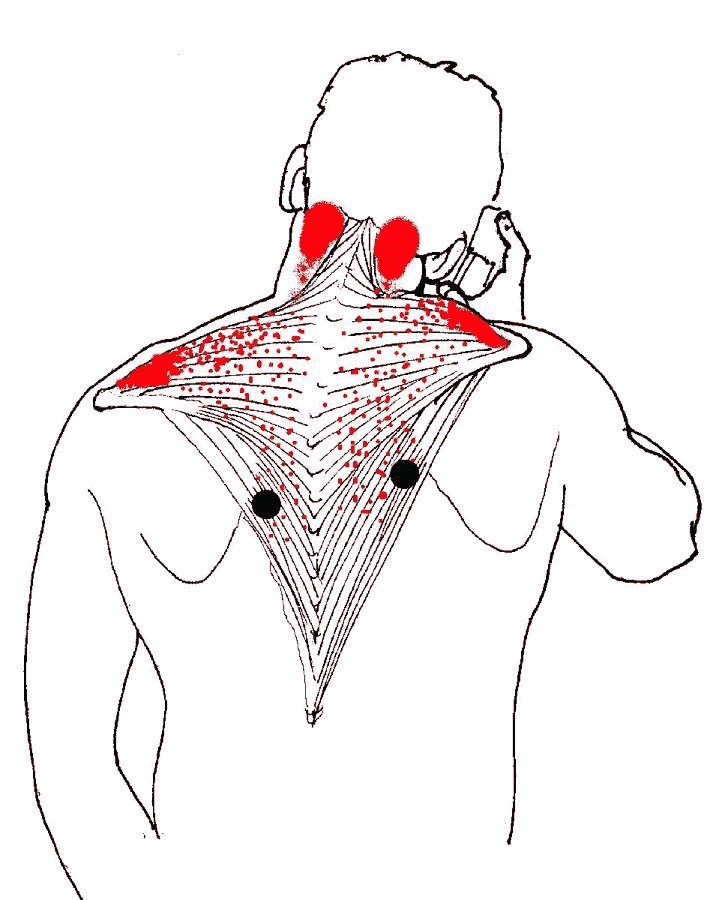
- Trapezius (Tension headache and "bursitis"). The
trapezius muscle of the back and neck is the single muscle most
likely to have trigger points in both adults and children.
Trapezius is a common victim of
poor posture, short pectoral muscles, badly designed furniture,
tote bags and cell phones. The upper
fibers are a common cause of
headache
but the middle and lower fibers are often ignored
by therapists.
TrPs in the middle and lower trapezius apparently
are responsible for the circles of pain commonly felt at the base of
the skull. They also cause diffuse upper back pain, burning pain
on the vertebral edge of the scapula, and pain at the point of the
shoulder (commonly interpreted as "bursitis").
A TrP (designated as TrP 3 by Travell & Simons)
is often found at the point where trapezius crosses the lower edge
of the scapula. This point appears to produce the more familiar upper
trapezius TrPs as satellites. In turn, the lower trapezius point
itself appears to be a satellite TrP of latissimus dorsi.
- Latissimus
Dorsi.
This powerful back muscle refers pain to the
lower shoulder blade and to the front of the shoulder where it
attaches. There may also be pain running along the medial side of
the arm down to the ring and little fingers and / or pain in the
side waist area. "Imaginary Lat Syndrome" (arms held out to the
sides as if unable to fall naturally) is common in new weight
lifters. Unfortunately, doing this strains the traps and shoulder
girdle muscles. If not imaginary, and accompanied by the
pain patterns shown here, lats may be chronically shortened and in
need of stretching. Lat pain referred to the lower edge of the
scapula is believed to create trapezius TrP3 which in turn creates
other TrPs in the upper fibers. See Trapezius above.
- Scalenes ("thoracic outlet" and "carpal tunnel"
syndromes; chest, arm, and upper back pain).
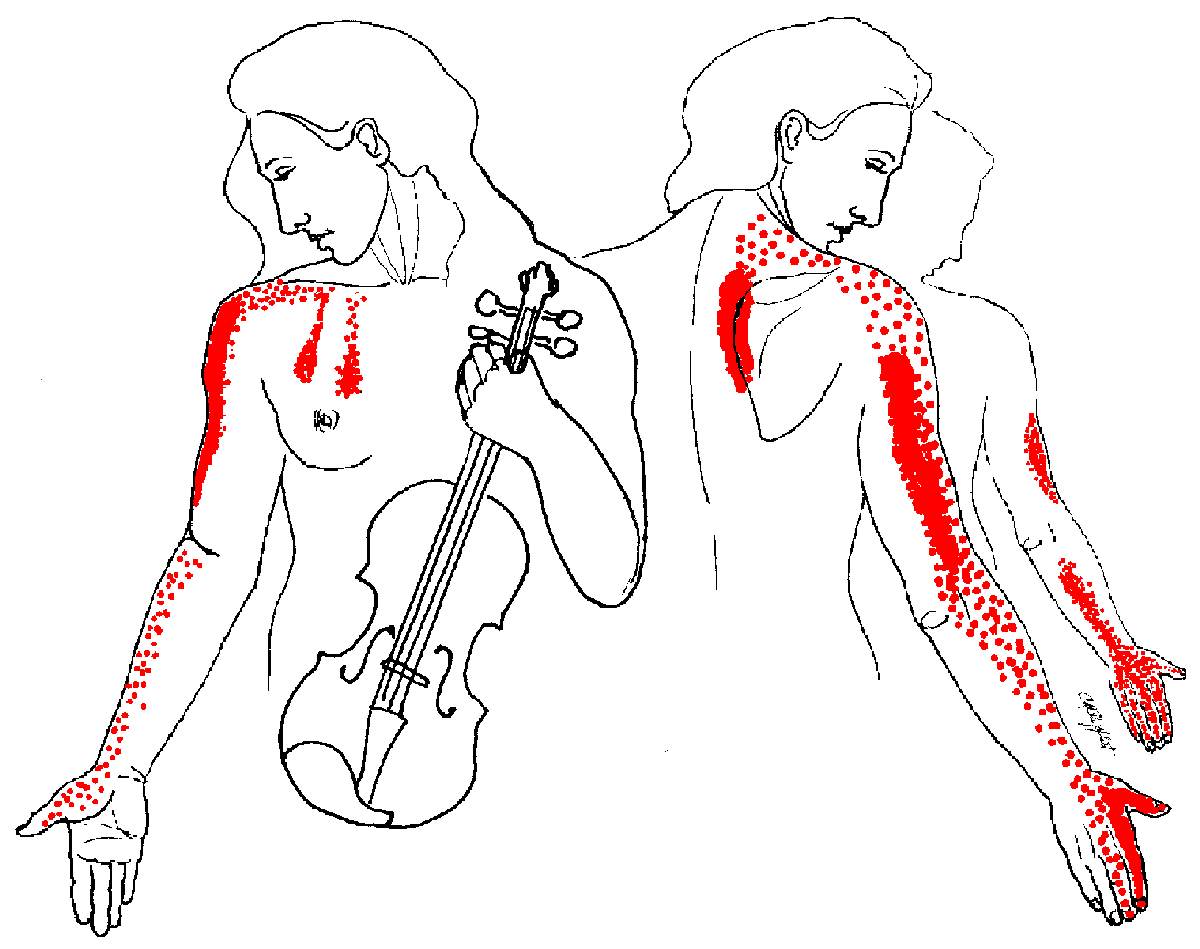 You may think you're having a heart attack.
Get it checked!
You may think you're having a heart attack.
Get it checked!
If no cardiac problems are found, consider
other muscles, especially if you have tingly thumb or index
fingers. Scalenes contribute to severe tension headache. They are
one of the leading causes of "carpal tunnel syndrome." On the list
of a half-dozen possible causes, the carpal tunnel itself is
dead last. Check before you cut!
In Aikido, new students tend
to interpret kokyu-nage techniques (actually based on timing
and balance) as: "Swing your partner around by the neck then drop him
on his head" -- an interesting variation on the game of “Hangman.”
In the NFL, doing the same thing to a large, padded, extremely fit
refrigerator-sized man by grabbing his face-guard is an instant 15-yard
penalty.
The
consequences of “neck-a-nage” can be extremely painful; the
electrical supply for arm and fingers comes from the brachial
plexus, the “wiring harness” originating in the neck. Pain may
extend into chest, shoulder, the area between the shoulder blades
and down the arm to the index finger and thumb. Where care and
consideration have failed, know this pain pattern and what to do
for it. A similar pattern arises from omohyoid, especially following
flu and any condition that involves bouts of vomiting.
The Rotator Cuff Muscles
- Supraspinatus (Rotator Cuff). Pain "above the spine of
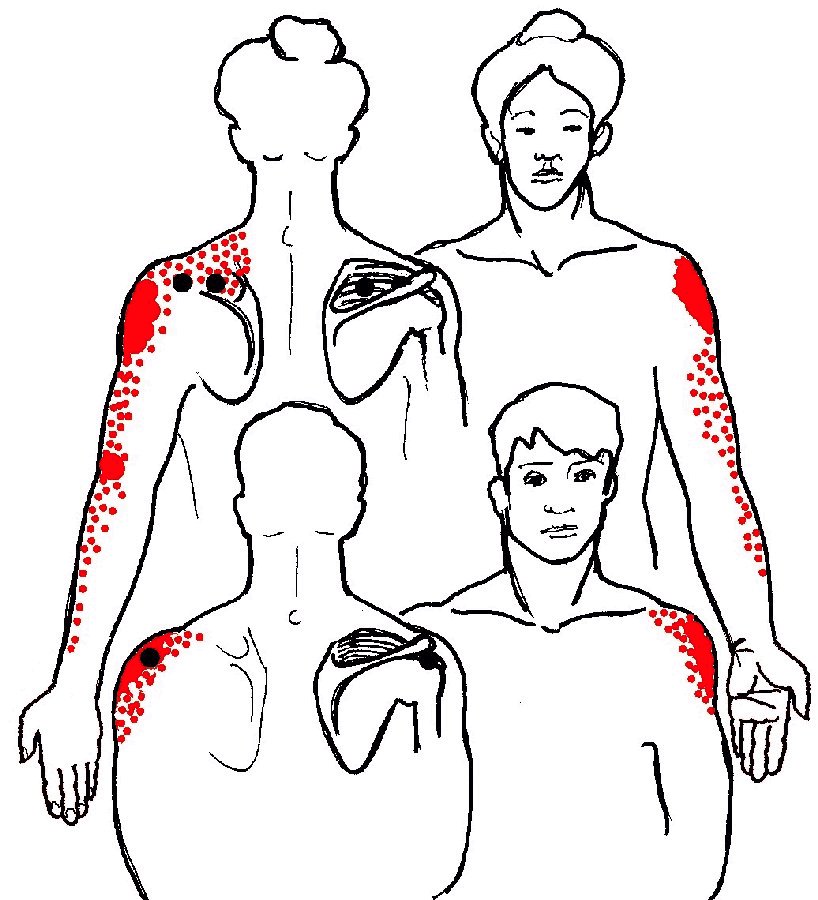 the scapula," strongest on outside of shoulder. It extends down the
arm to the elbow and possibly along the lateral (thumb side) of
the forearm. Commonly strained in association with infraspinatus.
the scapula," strongest on outside of shoulder. It extends down the
arm to the elbow and possibly along the lateral (thumb side) of
the forearm. Commonly strained in association with infraspinatus.
- Infraspinatus (Rotator Cuff). This muscle of
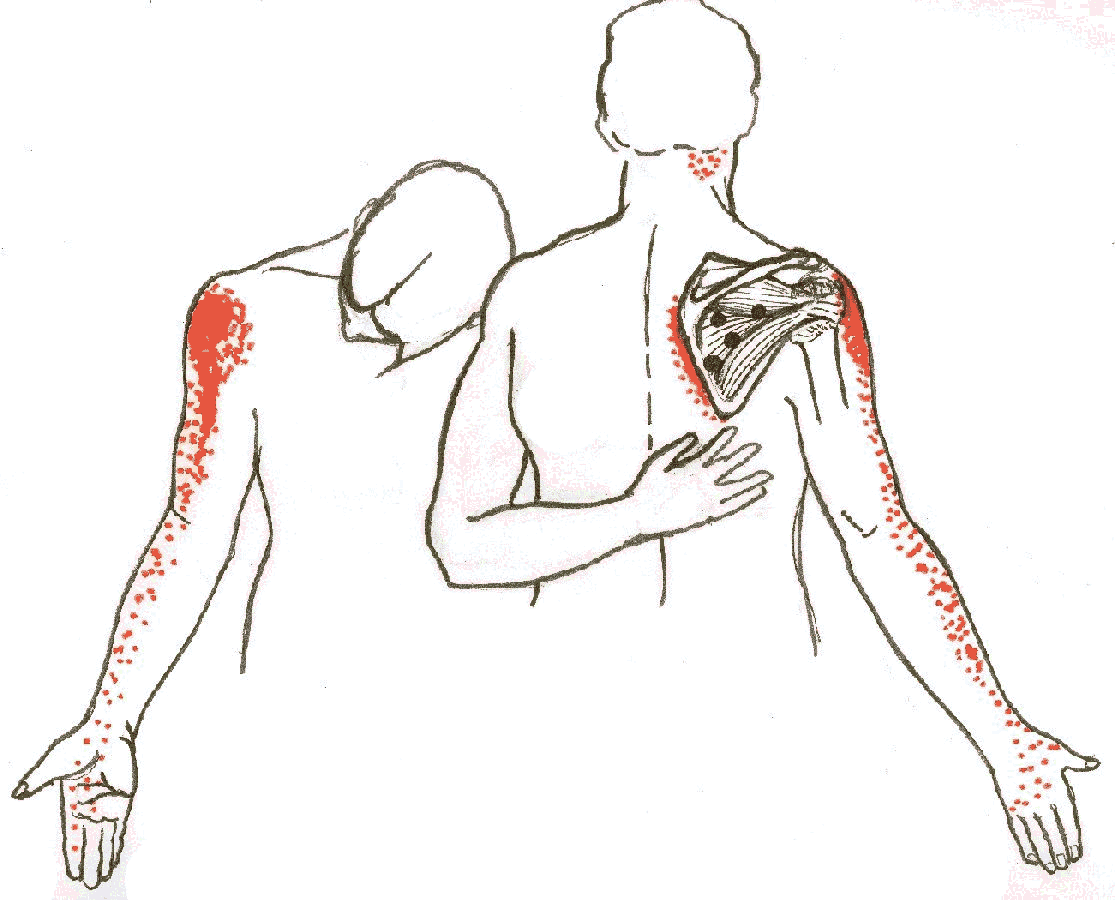 the back is a very common source of
pain on the lateral and front side of the shoulder. Pain is felt
deep in the shoulder joint, primarily at the front of the
shoulder. Pain may extend down lateral (thumb side) and anterior
("fishbelly") side of the arm as far as the front and back of the hand. the back is a very common source of
pain on the lateral and front side of the shoulder. Pain is felt
deep in the shoulder joint, primarily at the front of the
shoulder. Pain may extend down lateral (thumb side) and anterior
("fishbelly") side of the arm as far as the front and back of the hand.
Commonly injured in sudden abrupt arm movements such as catching
oneself when falling backwards or excessive poling while skiing.
Problems reaching your hip pocket? Chances are that the problem is infraspinatus,
possibly with a tight anterior deltoid. Infraspinatus is the major muscle
of (and "below the spine of") the scapula.
- Subscapularis (Rotator Cuff). This unfamiliar
muscle is a critical member of the
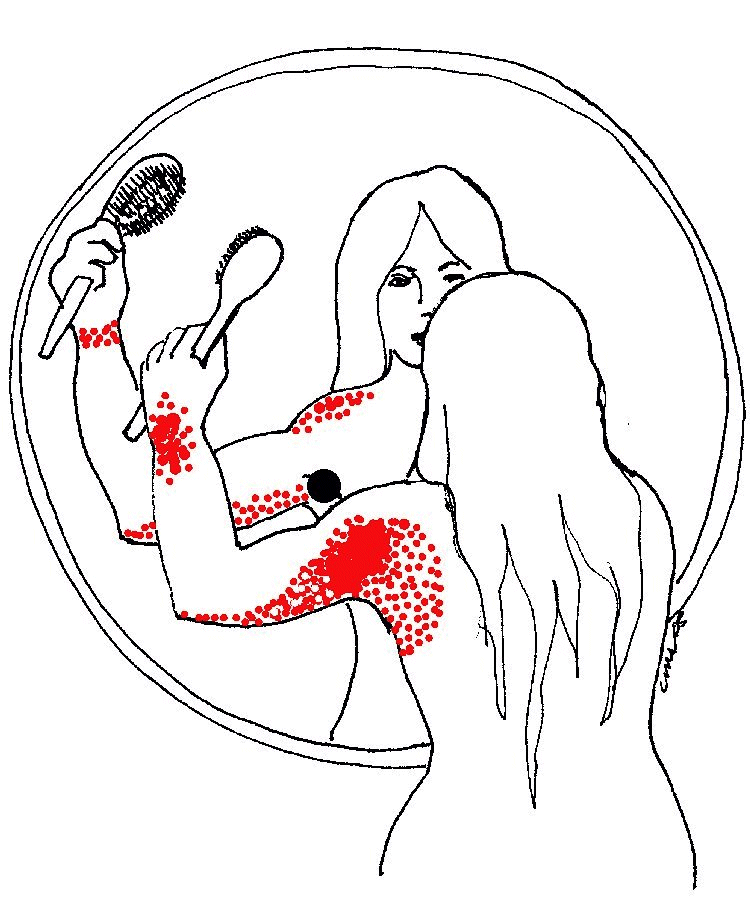 rotator cuff and a major player in the garbage-can diagnosis known
as "frozen shoulder."
rotator cuff and a major player in the garbage-can diagnosis known
as "frozen shoulder."
Subscapularis lines the entire underside of
the scapula, between scapula and rib cage, visible only in part
via the arm pit. Pain extends over the scapular area, into the
posterior shoulder (and possibly to the top of shoulder).
It may
be impossible or painful to raise the arm to comb hair. There may
be pain down the underside (medial side) of arm perhaps with an
odd bracelet of pain around the wrist and swelling on the back of
the hand. See more here.
- Teres Minor (Rotator Cuff). Refers "silver dollar pain"
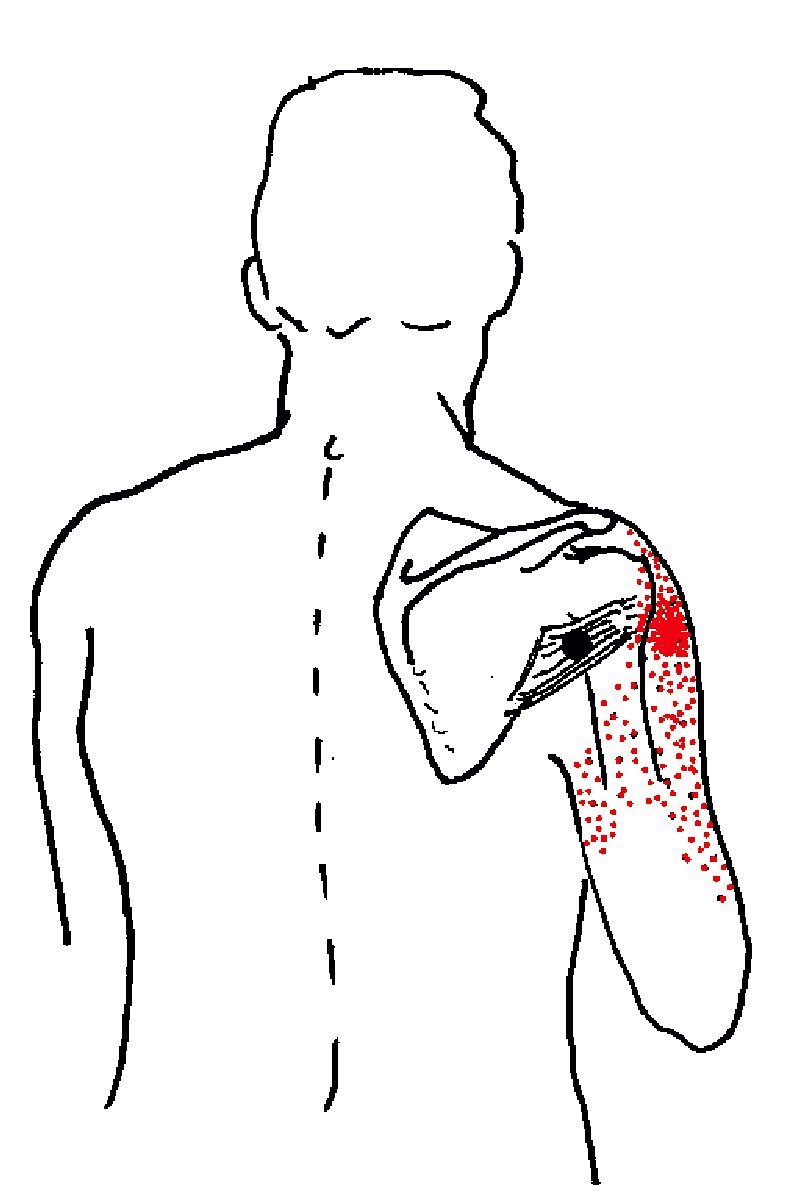 to the back of the arm, apparently deep in the posterior deltoid.
It may refer pain up to the shoulder and numbness and tingling
down to the fourth and fifth (ring and pinky) fingers.
to the back of the arm, apparently deep in the posterior deltoid.
It may refer pain up to the shoulder and numbness and tingling
down to the fourth and fifth (ring and pinky) fingers.
Teres minor rotates the arm laterally and is the smallest and
most "minor" of the rotator cuff muscles working in concert
with the infraspinatus.
Pain from this muscle
is sharply localized, deep and, notes Travell and
Simons, "about the size of a prune." The extremely localized nature
of teres minor pain is one of its best diagnostic features. However,
the teres muscles are two of the the least likely muscles to
have pain and trigger points in healthy persons.
Check teres if
pain and restriction remain after releasing the other rotator
cuff muscles -- especially if the sufferer plays volleyball or tennis.
The muscle is especially subject to strain when arms are extended high
over and behind the head as in serving a tennis ball or performing
or blocking a spike in volleyball.
Like so many other back and shoulder
muscles, teres minor is strained by tight pectoralis (chest) muscles. See
Pectoralis Major and Minor below.
- Teres Major. Pain to the shoulder over the region of
the posterior deltoid.
- Deltoids. One of the few muscles that actually hurts at
the source!. Pain may radiate down the arm as far as the
elbow, but the pain pattern is uncommonly local. Anterior deltoid
hurts in the front of the shoulder (with some spillover pain to
side and back). It restricts reach to the back.
Posterior
deltoid hurts in the back of the shoulder (with some spillover
pain to side and front). It restricts reach across the front of
the body. Deltoids may develop satellite TrPs due to pain referral
from other muscles as seen above. The flip side of saying deltoid
pain is "local" is, once again, that pain in the deltoids may be
coming from somewhere other than the deltoids.
- Pectoralis Major Pectoralis major is the
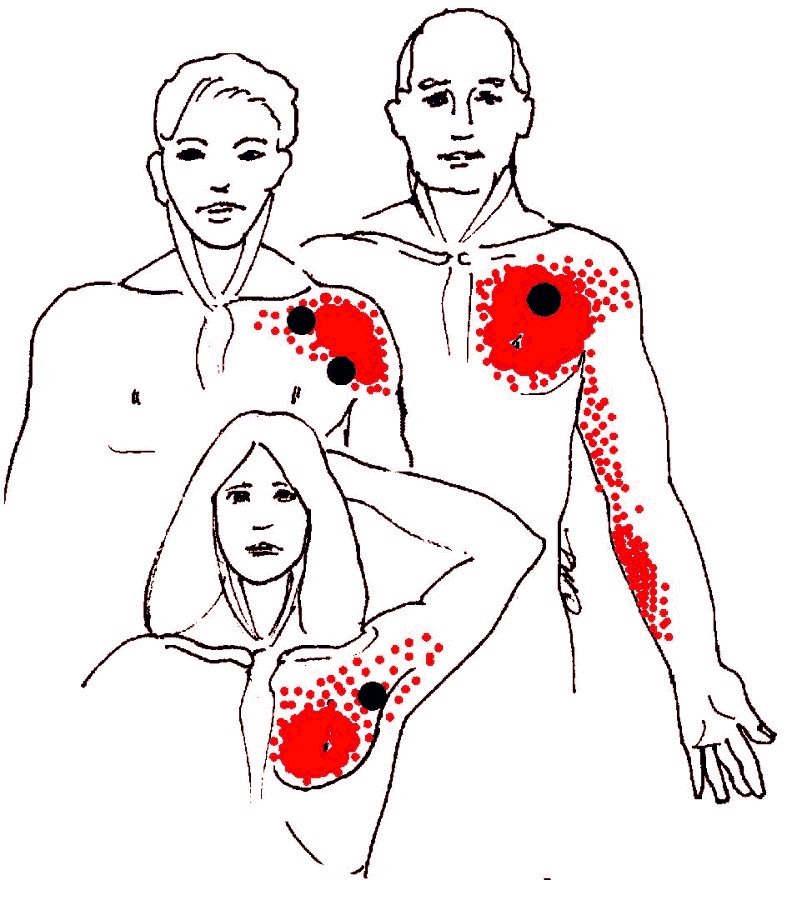 “major muscle of the chest.” The
shoulder, arm, and chest pain of this muscle suggest serious
disease. In women, breast pain is feared to be due to breast
cancer and patients may be sent for repeated mammograms
(ironically, exposing them to additional radiation). “major muscle of the chest.” The
shoulder, arm, and chest pain of this muscle suggest serious
disease. In women, breast pain is feared to be due to breast
cancer and patients may be sent for repeated mammograms
(ironically, exposing them to additional radiation).
Tight pectorals can also cause shoulder and chest pain extending down
the arm to below the elbow. In both men and women, this pattern
(especially when on the left side) can be terrifyingly similar to
the pain of angina and heart attack. Pectoralis major is strained
or shortened by: Hunching shoulders forward, sitting or sleeping
with arms crossed on chest, typing / keyboarding, sword work.
Conversely, pectoralis major
can develop painful TrPs following a heart attack. Pain reflexes
can shrink blood vessels, further starving the heart of blood.
There is even a pectoralis TrP that causes irregular heartbeat.
- Pectoralis Minor A leading cause of Thoracic Outlet
Syndrome and Carpal Tunnel Syndrome due to entrapment of the
brachial plexus and blood supply to the arm. Pain over the chest,
anterior shoulder, extending down the arm medial side (pinky side)
of arm as far as the last three (pinky, ring, and middle) fingers.
- Serratus Posterior Superior. Another unfamiliar muscle
which causes enormous amounts of pain. Pain concentrates over the
upper half of the scapula spilling over into the middle back
between scapula and spine. It extends to the posterior side of arm
and shoulder, down the back of the arm to the elbow and from there
to the back of the hand and lateral palm to the little finger.
There may also be pain in the chest and anterior arm.
- Coracobrachialis The TrP is in the shoulder at the
coracoid process of the scapula (for which it is named). You'll
get some severe pain there, but the pain also hops, skips, and
jumps down the posterior arm (missing the elbow) as far as the
back of the hand and the middle finger.
- Biceps Brachii You would think that this powerful
muscle would produce a similarly powerful pain pattern but it is,
in fact, fairly localized. TrPs in the muscle belly extend pain
down to attachments at elbow and shoulder.
- Brachialis. Known as "the workhorse of the elbow," this
muscle produces a weaker version of the Biceps pain pattern with
an interesting twist. The main pain is felt in the fleshy portion
of the base of the thumb.
- Triceps Brachii A major player in tennis elbow, but a
source of shoulder pain as well. Pain in posterior shoulder
extending as far up as the angle of the neck, down the back and
front of the arm and forearm. One of the three heads also entraps
the radial nerve causing slowed nerve conduction, numbness and
tingling in the two medial (pinky and ring) fingers.
- Levator scapula (Wry neck). This muscle is the number
one cause of "stiff" or "wry" neck and the second most common
shoulder girdle muscle (trapezius is Number One) to have trigger
points. Working with trapezius, levator shrugs the shoulders and
helps prevent forward flexion of the neck, hence it is also
damaged in whiplash injuries. It is commonly strained when
shoulder (or shoulders) are chronically hunched, either in stress,
or by attempting to keep a strap from sliding off the shoulder,
especially when muscle is cold or fatigued.
- Omohyoid (Head, neck, shoulder, and back pain). This
peculiar muscle, which doesn't even show up in a lot of anatomy
books can cause disabling pain and dysfunction. It's another one
of the muscles that attaches to the hyoid bone but the other end
attaches to the scapula. Aside from the pain (which often appears
after a bout of coughing or vomiting) there may also be weakness
and tingling down arm and fingers (similar to the scalene pattern)
and symptoms of thoracic outlet syndrome.
- Rhomboids Not exactly shoulder pain, but certainly
related. Rhomboid pain is fairly localized, appearing between the
shoulder blades, the place where everyone loves a backrub. Pain
may extend out across the top of the scapula towards (but not up
to) the neck. Again, local pain, but commonly fired off as
satellites of pain patterns from other muscles, especially the
scalene muscles of the neck, serratus posterior superior, and
levator scapula.
- Subclavius This odd little muscle depresses and
stabilizes the clavicle (collarbone). It also refers pain locally
to the front of the clavicle and anterior shoulder, down the
anterior arm along the biceps and the lateral (thumb) side of the
arm as far as the thumb, index, and middle fingers. Another
referral patten that may be mistaken for Carpal Tunnel Syndrome.
|
|

 You may think you're having a heart attack.
Get it checked!
You may think you're having a heart attack.
Get it checked!  the scapula," strongest on outside of shoulder. It extends down the
arm to the elbow and possibly along the lateral (thumb side) of
the forearm. Commonly strained in association with infraspinatus.
the scapula," strongest on outside of shoulder. It extends down the
arm to the elbow and possibly along the lateral (thumb side) of
the forearm. Commonly strained in association with infraspinatus.
 the back is a very common source of
pain on the lateral and front side of the shoulder. Pain is felt
deep in the shoulder joint, primarily at the front of the
shoulder. Pain may extend down lateral (thumb side) and anterior
("fishbelly") side of the arm as far as the front and back of the hand.
the back is a very common source of
pain on the lateral and front side of the shoulder. Pain is felt
deep in the shoulder joint, primarily at the front of the
shoulder. Pain may extend down lateral (thumb side) and anterior
("fishbelly") side of the arm as far as the front and back of the hand.
 rotator cuff and a major player in the garbage-can diagnosis known
as "frozen shoulder."
rotator cuff and a major player in the garbage-can diagnosis known
as "frozen shoulder."
 to the back of the arm, apparently deep in the posterior deltoid.
It may refer pain up to the shoulder and numbness and tingling
down to the fourth and fifth (ring and pinky) fingers.
to the back of the arm, apparently deep in the posterior deltoid.
It may refer pain up to the shoulder and numbness and tingling
down to the fourth and fifth (ring and pinky) fingers.
 “major muscle of the chest.” The
shoulder, arm, and chest pain of this muscle suggest serious
disease. In women, breast pain is feared to be due to breast
cancer and patients may be sent for repeated mammograms
(ironically, exposing them to additional radiation).
“major muscle of the chest.” The
shoulder, arm, and chest pain of this muscle suggest serious
disease. In women, breast pain is feared to be due to breast
cancer and patients may be sent for repeated mammograms
(ironically, exposing them to additional radiation).